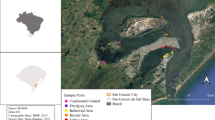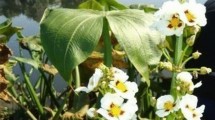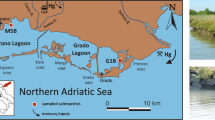Abstract
Vascular plants in salt marshes strongly influence processes of heavy metal accumulation. Many studies have focused on this issue; however, there is a lack of information regarding the effects of plants on the distribution of certain poorly studied metals, such as Co, Cr, and Ni. The aim of this study was to comparatively evaluate the capability of Spartina densiflora Brongn. and Spartina maritima (Curtis) Fernald, to accumulate Co, Cr, and Ni and influence the sediment composition around their roots, investigating whether the observed behavior can change with different levels of sediment pollution. Concentrations of Co, Cr, and Ni were determined in tissues of S. densiflora and S. maritima and in sediments and rhizosediments from the Odiel and Tinto marshes (SW Spain), one of the estuaries most polluted by heavy metals in the world. Concentrations of Co, Cr, and Ni in the belowground tissues of both Spartina species were higher than those in aboveground tissues in all sites sampled. Both species showed potential for phytostabilization of Co, possibly by promoting the formation of high amounts of Fe-oxides in the rhizosphere, which can act to retain the metal within the sediment around the roots. In addition, both Spartina species were found to accumulate Co in their roots, thereby avoiding the translocation of this metal to photosynthetic tissues. At the Tinto marsh, there were no differences recorded in metal levels between sediments and rhizosediments of both species, a fact that could be explained by the extremely high background levels of metals at this site, which may impair the ability of the plant to alter the chemistry of the sediment in contact with the roots. The potential for the immobilization of a large amount of Co in the soil, exhibited by S. densiflora and S. maritima, indicates that both species could be highly useful in the phytostabilization of Co contaminated environments.


Similar content being viewed by others
References
Alberts, J. J., M. T. Price & M. Kania, 1990. Metal concentrations in tissues of Spartina alterniflora (Loisel.) and sediments of Georgia salt marshes. Estuarine, Coastal and Shelf Science 30: 47–58.
Almeida, C. M., A. P. Mucha & M. T. Vasconcelos, 2004. Influence of the sea rush Juncus maritimus on metal concentration and speciation in estuarine sediment colonized by the plant. Environmental Science and Technology 38: 3112–3118.
Almeida, C. M. R., A. P. Mucha & M. T. S. D. Vasconcelos, 2006. Comparison of the role of the sea club-rush Scirpus maritimus and the sea rush Juncus maritimus in terms of concentration, speciation and bioaccumulation of metals in the estuarine sediment. Environmental Pollution 142: 151–159.
Bolt, G. H. & M. G. M. Bruggenwert, 1976. Soil Chemistry. A. Basic Elements. Elsevier, Amsterdam.
Bortolus, A., 2006. The austral cordgrass Spartina densiflora Brong.: its taxonomy, biogeography and natural history. Journal of Biogeography 33: 158–168.
Bouyoucos, G. J., 1936. Directions for making mechanical analysis of soils by the hydrometer method. Soil Science 42: 225–228.
Bowen, H. J. M., 1979. Environmental Chemistry of the Elements. Academic Press, New York.
Breteler, R. J. & J. M. Teal, 1981. Trace element enrichments in decomposing litter of Spartina alterniflora. Aquatic Botany 11: 111–120.
Burke, D. J., J. S. Weis & P. Weis, 2000. Release of metals by the leaves of the salt marsh grasses Spartina alterniflora and Phragmites australis. Estuarine, Coastal Shelf Science 51: 153–159.
Caçador, I., C. Vale & F. Catarino, 1996. Accumulation of Zn, Pb, Cu, Cr and Ni in sediments between roots of the Tagus estuary salt marshes, Portugal. Estuarine, Coastal and Shelf Science 42: 393–403.
Caçador, I., M. Caetano, B. Duarte & C. Vale, 2009. Stock and losses of trace metals from salt marsh plants. Marine Environmental Research 67: 75–82.
Caetano, M., C. Vale, R. Cesário & N. Fonseca, 2008. Evidence for preferential depths of metal retention in roots of salt marsh plants. Science of the Total Environment 390: 466–474.
Cambrollé, J., S. Redondo-Gómez, E. Mateos-Naranjo & M. E. Figueroa, 2008. Comparison of the role of two Spartina species in terms of phytostabilization and bioaccumulation of metals in the estuarine sediment. Marine Pollution Bulletin 56: 2037–2042.
Carbonell, A. A., M. A. Aarabi, R. D. DeLaune, R. P. Gambrell & W. H. Patrick Jr, 1998. Bioavailability and uptake of arsenic by wetland vegetation: effects on plant growth and nutrition. Journal of Environmental Science and Health 33: 45–66.
Castillo, J. M., L. Fernández-Baco, E. M. Castellanos, C. J. Luque, M. E. Figueroa & A. J. Davy, 2000. Lower limits of Spartina densiflora and S. maritima in the salt-marsh tidal frame determined by differential ecophysiological tolerances. Journal of Ecology 88: 801–812.
Cataldo, D. A., T. R. Garland & R. E. Wildung, 1978. Nickel in plants. Plant Physiology 62: 566–570.
Comerford, N. B., 2005. Soil factors affecting nutrient bioavailability. In Bassirirad, H. (ed.), Nutrient Acquisition by Plants. An Ecological Perspective, Vol. 181. Springer-Verlag, Heidelberg, Series: Ecological Studies: 1–14.
Davis, R. A., A. T. Welty, J. Borrego, J. A. Morales, J. G. Pendón & J. G. Ryan, 2000. Rio Tinto estuary (Spain): 5000 years of pollution. Environmental Geology 39: 1107–1116.
Denny, P., R. Bailey, E. Tukahirwa & P. Mafabi, 1995. Heavy metal contamination of Lake George (Uganda) and its wetlands. Hydrobiologia 297: 229–239.
Echevarria, G., P. C. Vong, E. Leclerc-Cessac & J. L. Morel, 1997. Bioavailability of technetium-99 as affected by plant species and growth, application form, and soil incubation. Journal of Environmental Quality 26: 947–956.
Egal, M., F. Elbaz-Poulichet, C. Casiot, M. Motelica-Heino, P. Négrel, O. Bruneel, A. M. Sarmiento & J. M. Nieto, 2008. Iron isotopes in acid mine waters and iron-rich solids from the Tinto–Odiel Basin (Iberian Pyrite Belt, Southwest Spain). Chemical Geology 253: 162–171.
Figueroa, M. E. & E. M. Castellanos, 1988. Vertical structure of Spartina maritima and Spartina densiflora in Mediterranean marshes. In Werger, M. J. A., P. J. M. van der Aart, H. J. During & J. T. A. Verhoeven (eds), Plant Form and Vegetation Structure. SPB Academic Publishing, The Hague: 105–108.
Figueroa, M. E., J. M. Castillo, S. Redondo, T. Luque, E. M. Castellanos, F. J. Nieva, C. J. Luque, A. E. Rubio-Casal & A. J. Davy, 2003. Facilitated invasion by hybridization of Sarcocornia species in a salt-marsh succession. Journal of Ecology 91: 616–626.
González-Pérez, J. A., J. R. De Andrés, L. Clemente, J. A. Martín & F. J. González-Vila, 2007. Organic carbon and environmental quality of riverine and off-shore sediments from the Gulf of Cádiz, Spain. Environmental Chemistry Letters 6: 41–46.
Hansel, C., S. Fendorf, S. Sutton & M. Newville, 2001. Characterization of Fe plaque and associated metals on the roots of mine-waste impacted aquatic plants. Environmental Science and Technology 35: 3863–3868.
Hu, H., 2002. Human health and heavy metals exposure. In McCally, M. (ed.), Life Support: The Environment and Human Health. MIT Press, Cambridge: 65–82.
Jacob, D. L. & M. L. Otte, 2003. Conflicting processes in the wetland plant rhizosphere: metal retention or mobilization? Water, Air, and Soil Pollution 3: 91–104.
Kabata-Pendias, A. & H. Pendias, 2001. Trace Elements in Soils and Plants. CRC Press, Florida.
Luque, C. J., E. M. Castellanos, J. M. Castillo, M. Gonzalez, M. C. Gonzalez-Vilches & M. E. Figueroa, 1999. Metals in halophytes of a contaminated estuary (Odiel Saltmarshes, SW Spain). Marine Pollution Bulletin 38: 49–51.
Madureira, M. J., C. Vale & M. L. Gonçalves, 1997. Effect of plant on sulphur geochemistry in the Tagus SALT-marshes sediments. Marine Chemistry 58: 27–37.
Mertz, W., E. E. Angino, H. L. Cannon, K. M. Hambidge & A. W. Voors, 1974. Chromium. In Mertz, W. (ed.), Geochemistry and the Environment. N.A.S., Washington, DC: 29–35.
Morillo, J., J. Usero & R. Rojas, 2008. Fractionation of metals and As in sediments from a biosphere reserve (Odiel salt marshes) affected by acidic mine drainage. Environmental Monitoring and Assessment 139: 329–337.
Nieva, F. J. J., A. Díaz-Espejo, E. M. Castellanos & M. E. Figueroa, 2001. Field variability of invading populations of Spartina densiflora Brong. in different habitats of the Odiel marshes (SW Spain). Estuarine, Coastal and Shelf Science 52: 515–527.
Reboreda, R., I. Caçador, S. Pedro & P. R. Almeida, 2008. Mobility of metals in salt marsh sediments colonised by Spartina maritima (Tagus estuary, Portugal). Hydrobiologia 606: 129–137.
Redondo-Gómez, S., E. Mateos-Naranjo, A. J. Davy, F. Fernández-Muñoz, E. M. Castellanos, T. Luque & M. E. Figueroa, 2007. Growth and photosynthetic responses to salinity of the salt-marsh shrub Atriplex portulacoides. Annals of Botany 100: 555–563.
Ruiz, F., 2001. Trace metals in estuarine sediments of south-western Spain. Marine Pollution Bulletin 42: 481–489.
Sáinz, A. & F. Ruiz, 2006. Influence of the very polluted inputs of the Tinto-Odiel system on the adjacent littoral sediments of southwestern Spain: a statistical approach. Chemosphere 62: 1612–1622.
Sawidis, T., M. Chettri, G. A. Zazhariadis & J. A. Stratis, 1995. Heavy metals in aquatic plants and sediments from water systems in Macedonia, Greece. Ecotoxicology and Environmental Safety 32: 73–80.
Sillanpää, M. & H. Jansson, 1992. Status of cadmium, lead, cobalt and selenium in soils and plants of thirty countries. FAO Soil Bulletin 65.
Sneller, F. E., E. C. Noordover, W. Ten Bookem, H. Schat, J. Bedaux & J. Verkleij, 1999. Quantitative relationship between phytochelatin accumulation and growth inhibition during prolonged exposure to cadmium in Silene vulgaris. Ecotoxicology 8: 167–175.
Weis, J. S. & P. Weis, 2004. Metal uptake, transport and release by wetland plants: implications for phytoremediation and restoration. Environment International 30: 685–700.
Weis, P., L. Windham, D. J. Burke & J. S. Weis, 2002. Release into the environment of metals by two vascular salt marsh plants. Marine Environmental Research 54: 325–329.
Weiss, J., M. Hondzo, D. Biesboer & M. Semmens, 2006. Laboratory study of heavy metal phytoremediation by three wetland macrophytes. International Journal of Phytoremediation 8: 245–259.
Williams, T. P., J. M. Bubb & J. N. Lester, 1994. Metal accumulation within salt marsh environments: a review. Marine Pollution Bulletin 28: 277–290.
Windham, L., J. S. Weis & P. Weis, 2003. Uptake and distribution of metals in two dominant salt marsh macrophytes, Spartina alterniflora (cordgrass) and Phragmites australis (common reed). Estuarine, Coastal and Shelf Science 56: 63–72.
Acknowledgments
We are grateful to Mr. K. MacMillan for the revision of the English version of the manuscript. We also thank the Spanish Ministry of Education (FPU programme, AP2007-04420), the Junta de Andalucía for financial support (RMN-224), and the Directorate of the Odiel Marshes Natural Park for their collaboration.
Author information
Authors and Affiliations
Corresponding author
Additional information
Handling editor: Karen McKee
Rights and permissions
About this article
Cite this article
Cambrollé, J., Mateos-Naranjo, E., Redondo-Gómez, S. et al. The role of two Spartina species in phytostabilization and bioaccumulation of Co, Cr, and Ni in the Tinto–Odiel estuary (SW Spain). Hydrobiologia 671, 95–103 (2011). https://doi.org/10.1007/s10750-011-0706-4
Received:
Revised:
Accepted:
Published:
Issue Date:
DOI: https://doi.org/10.1007/s10750-011-0706-4




